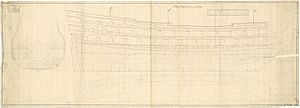HMS Boyne (1692) facts for kids

Boyne (1708 plan)
|
|
Quick facts for kids History |
|
|---|---|
| Name | HMS Boyne |
| Namesake | Battle of the Boyne (1690) |
| Builder | Harding, Deptford Dockyard |
| Launched | 21 May 1692 |
| Fate | Broken up, 1763 |
| General characteristics as built | |
| Class and type | 80-gun third-rate ship of the line |
| Tons burthen | 1,160 tons BM |
| Length | 157 ft (47.9 m) (gundeck) |
| Beam | 41 ft 3 in (12.6 m) |
| Depth of hold | 17 ft 3 in (5.3 m) |
| Propulsion | Sails |
| Sail plan | Full-rigged ship |
| Armament | 80 guns of various weights of shot |
| General characteristics after 1708 rebuild | |
| Class and type | 1706 Establishment 80-gun third-rate ship of the line |
| Tons burthen | 1,301 tons BM |
| Length | 156 ft (47.5 m) (gundeck) |
| Beam | 43 ft 6 in (13.3 m) |
| Depth of hold | 17 ft 8 in (5.4 m) |
| Propulsion | Sails |
| Sail plan | Full-rigged ship |
| Armament |
|
| General characteristics after 1739 rebuild | |
| Class and type | 1733 proposals 80-gun third-rate ship of the line |
| Tons burthen | 1,390 |
| Length | 158 ft (48.2 m) (gundeck) |
| Beam | 45 ft 5 in (13.8 m) |
| Depth of hold | 18 ft 7 in (5.7 m) |
| Propulsion | Sails |
| Sail plan | Full-rigged ship |
| Armament |
|
HMS Boyne was a powerful warship from the Royal Navy, the navy of Great Britain. It was an 80-gun ship of the line, meaning it was a large sailing ship designed for naval battles. These ships carried many cannons on different decks. The Boyne was named after the Battle of the Boyne, a famous battle from 1690. It was built at Deptford Dockyard and first launched on May 21, 1692.
Contents
The Boyne's Design and Rebuilds
A "ship of the line" was a warship strong enough to be part of the main battle line during a naval fight. The Boyne was an "80-gun" ship, meaning it carried 80 cannons. It was also a "third-rate" ship, which was a way to classify warships based on their size and number of guns.
First Major Rebuild: More Gun Decks
The Boyne went through several big changes during its life. Its first major rebuild happened at Blackwall Yard. This was done according to the "1706 Establishment," which was a set of rules for how warships should be built. During this rebuild, the ship's design was updated.
Originally, the Boyne had two main decks for its cannons. After the 1708 rebuild, it had three gun decks. Even with this change, it was still called a "third-rate" ship. It was relaunched on March 26, 1708, ready for new missions.
Second Major Rebuild: New Ship Standards
The Boyne had a second major rebuild at Deptford. This time, it was updated to the "1719 Establishment" standards, specifically following proposals from 1733. These "Establishments" were like blueprints that the Royal Navy used to make sure their ships were built to a certain size and strength.
This second rebuild made the Boyne even stronger and more modern for its time. It was relaunched again on May 28, 1739.
Boyne in Action: The War of Jenkins' Ear
The Boyne played a part in an important conflict called the War of Jenkins' Ear. This war was fought between Great Britain and Spain. It started because of trade disputes and a famous incident involving a British sailor named Robert Jenkins, whose ear was supposedly cut off by Spanish guards.
Expedition to Cartagena de Indias
During this war, the Boyne joined a large fleet led by Vice-Admiral Edward Vernon. This fleet sailed to the Caribbean to attack Spanish territories. One of their main targets was Cartagena de Indias, a very important Spanish port city in what is now Colombia.
The Boyne took part in the Battle of Cartagena de Indias, which was a major effort to capture the city. This battle was a tough fight, showing the challenges of naval warfare in the 18th century.
The End of the Boyne
After many years of service, HMS Boyne was eventually taken apart. This process, called "broken up," happened in 1763. It meant the ship was dismantled, and its useful parts were salvaged.

